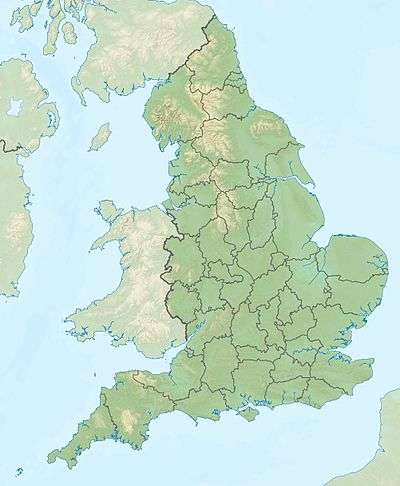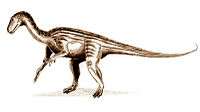Magnesian Conglomerate
The Magnesian Conglomerate is a geological formation in Clifton, Bristol in England (originally Avon). It dates back to the Rhaetian stage of the Late Triassic.[1][2] This formation was first studied in 1836 by Henry Riley and Samuel Stutchbury.[3]
| Magnesian Conglomerate Stratigraphic range: Rhaetian ~208–202 Ma | |
|---|---|
| Type | Geological formation |
| Lithology | |
| Primary | Breccia |
| Other | Limestone |
| Location | |
| Coordinates | 51.5°N 2.6°W |
| Approximate paleocoordinates | 35.9°N 0.8°E |
| Region | South West England |
| Country | |
| Extent | Bristol |
| Type section | |
| Named by | Henry Riley & Samuel Stutchbury |
| Year defined | 1836 |
 Magnesian Conglomerate (England) | |
The Avon Fissure Fill is probably the same formation as the Magnesian Conglomerate.
Vertebrate paleofauna
Archosaurs
| Archosaurs of the Magnesian Conglomerate | ||||
|---|---|---|---|---|
| Taxa | Presence | Notes | Images | |
Genus:
|
 | |||
| Genus: |  | |||
Suborder:
|
||||
Fish
- Lissodus minimus[5]
- Rhomphaiodon minor[5]
- ?Hybodontiformes indet.[5]
gollark: My browser's element inspector *says* you have some empty `<p>` tags, so it looks like you just managed to mess it up and the browser displays it in a vaguely coherent-looking way.
gollark: You seem to have some random unclosed `<b>` tags... in the middle of other stuff...
gollark: This... also isn't really spec compliant and should probably not parse.
gollark: Also, `<br>`s everywhere for layout are kind of bad, you can do margins/padding in CSS.
gollark: Although... *why* do you have empty `<p></p>` tags and why does this use `<b>` everywhere?
See also
- List of dinosaur-bearing rock formations
- List of fossiliferous stratigraphic units in England
References
- Magnesian Conglomerate in the Paleobiology Database
- Weishampel et al., 2004, pp. 521–525
- Riley & Stutchbury, 1836
- Durdham Down, Quarry Steps in the Paleobiology Database
- Foffa et al., 2014
Bibliography
- Foffa, D.; D. I. Whiteside; P. A. Viegas, and M. J. Benton. 2014. Vertebrates from the Late Triassic Thecodontosaurus-bearing rocks of Durdham Down, Clifton (Bristol, UK). Proceedings of the Geologists' Association 125. 317–332.
- Weishampel, David B.; Peter Dodson, and Halszka Osmólska (eds.). 2004. The Dinosauria, 2nd edition, 1–880. Berkeley: University of California Press. Accessed 2019-02-21. ISBN 0-520-24209-2
- Riley, H., and S. Stutchbury. 1836. A description of various fossil remains of three distinct saurian animals discovered in the autumn of 1834 in the Magnesian Conglomerate on Durdham Down near Bristol. Proceedings of the Geological Society 2. 397–399.
Further reading
- Riley, H. and Stutchbury, S. 1840. A description of various fossil remains of three distinct saurian animals recently discovered in the Magnesian Conglomerate near Bristol Transactions of the Geological Society of London 5, 349–357
- W. Buckland. 1824. Reliquiæ Diluvianæ; or, Observations on the Organic Remains Contained in Caves, Fissures, and Diluvial Gravel, and on Other Geological Phenomena, Attesting the Action of an Universal Deluge. Second Edition. John Murray, London 1-303
External links
This article is issued from Wikipedia. The text is licensed under Creative Commons - Attribution - Sharealike. Additional terms may apply for the media files.